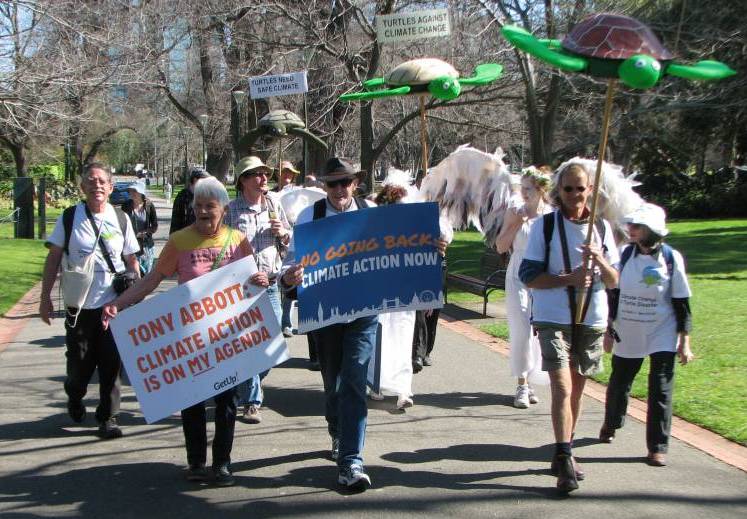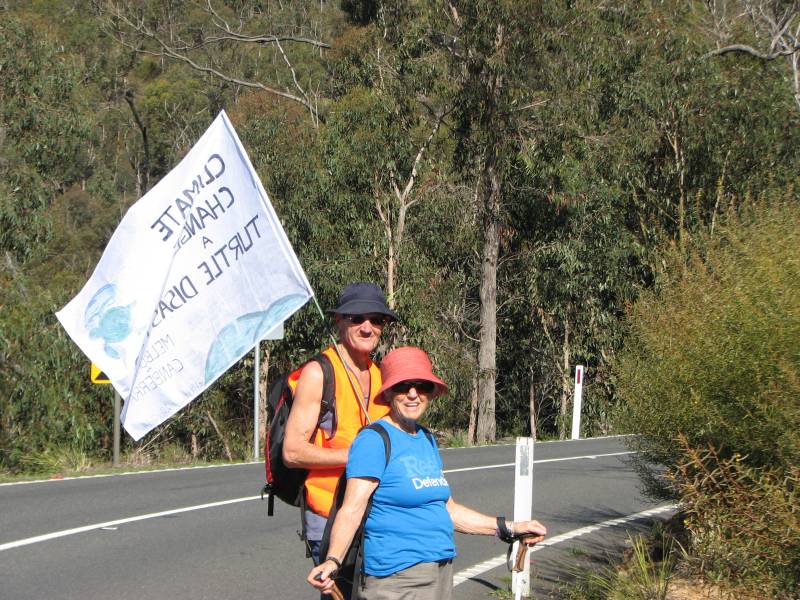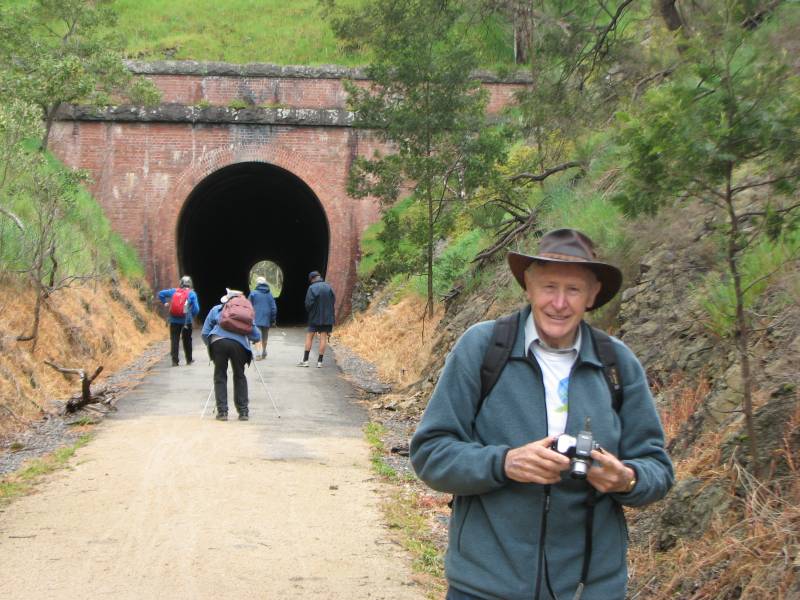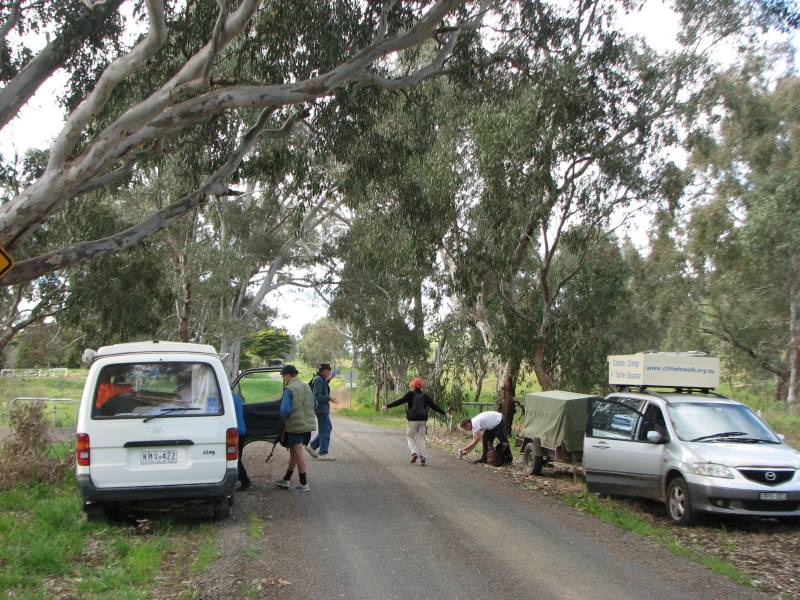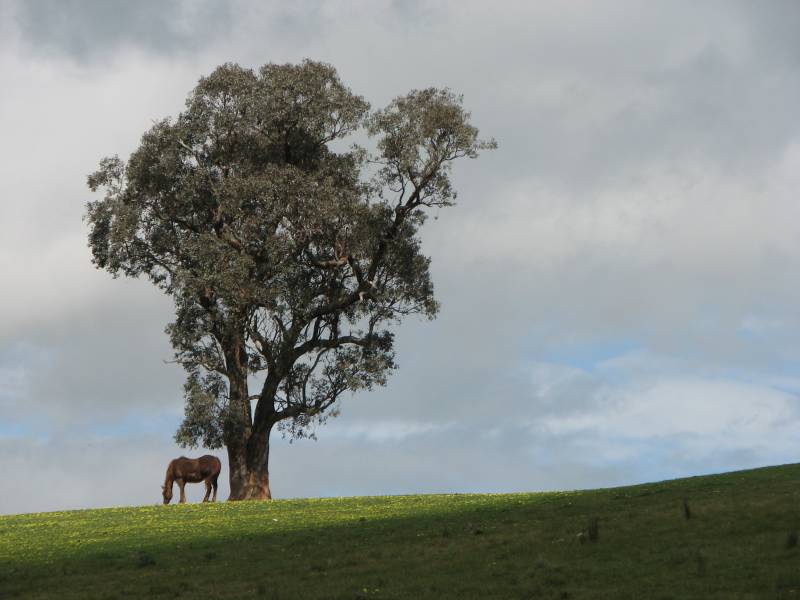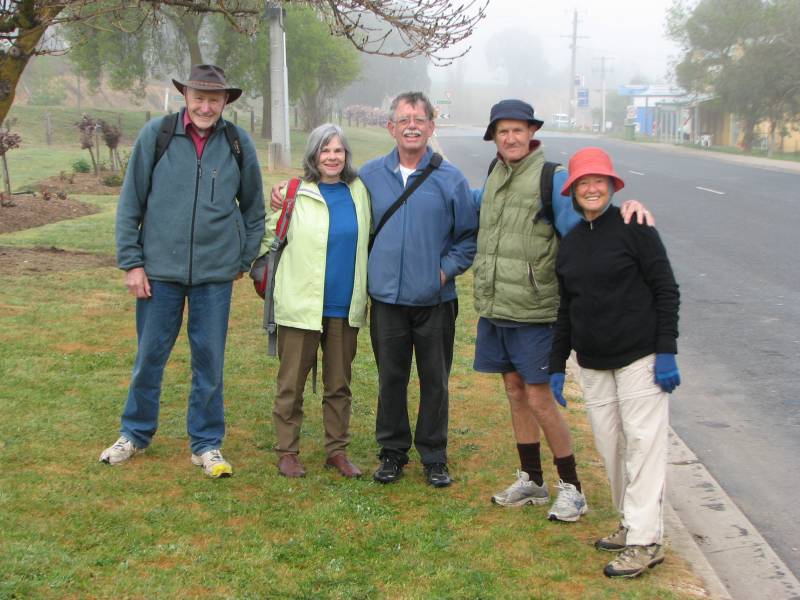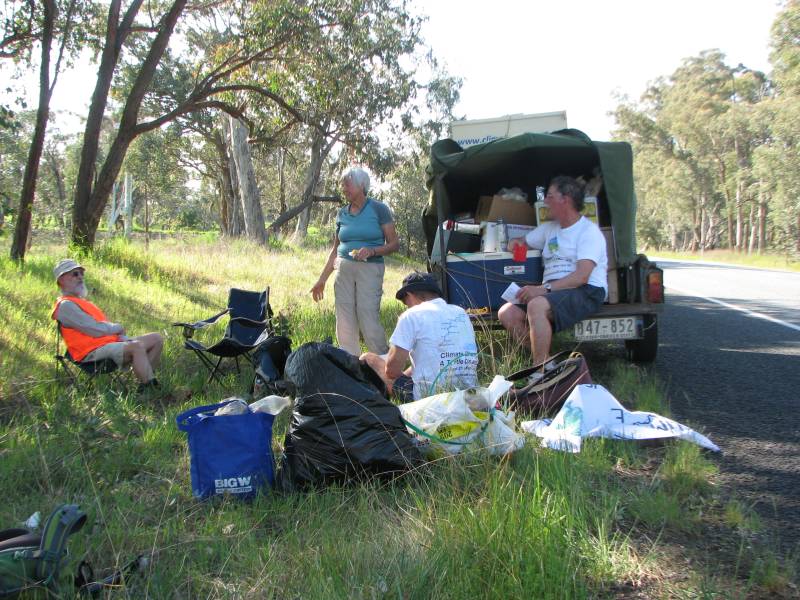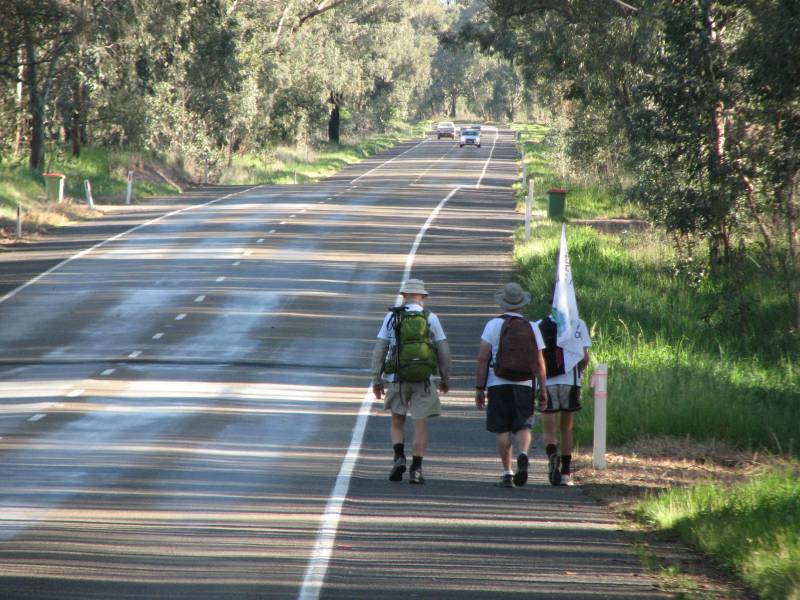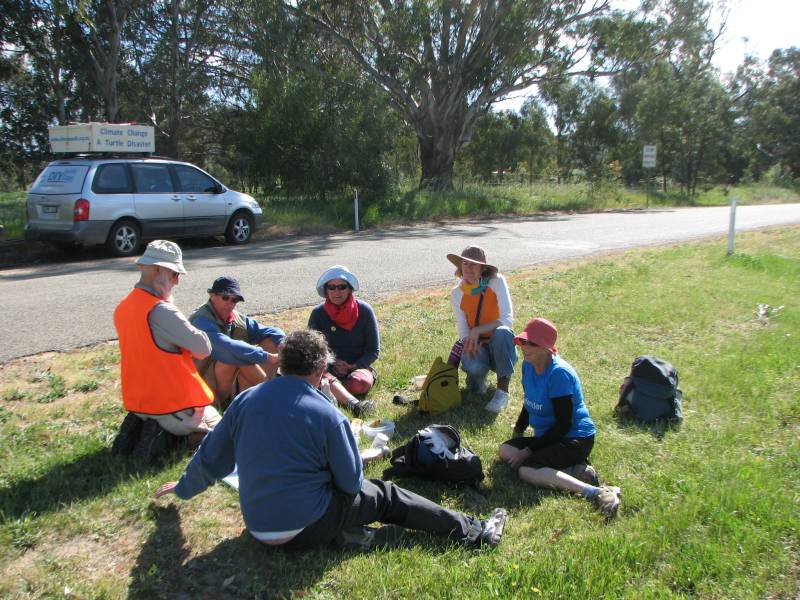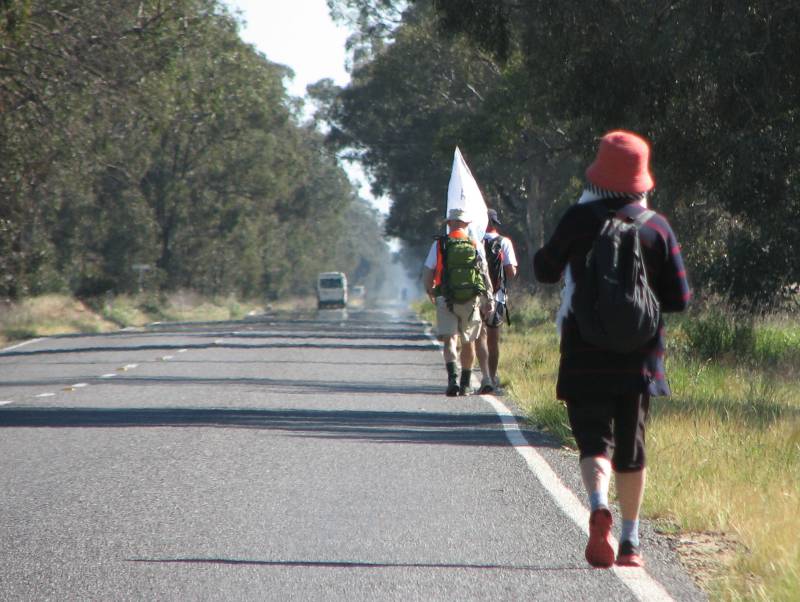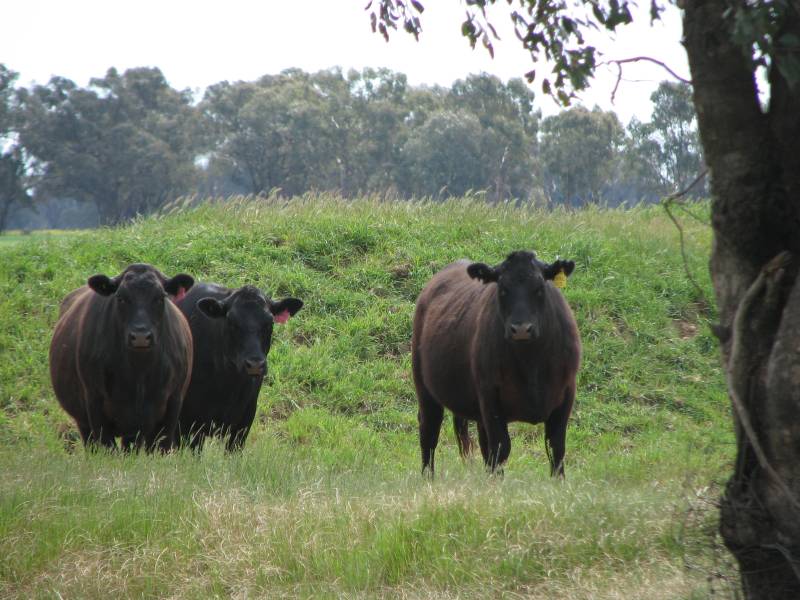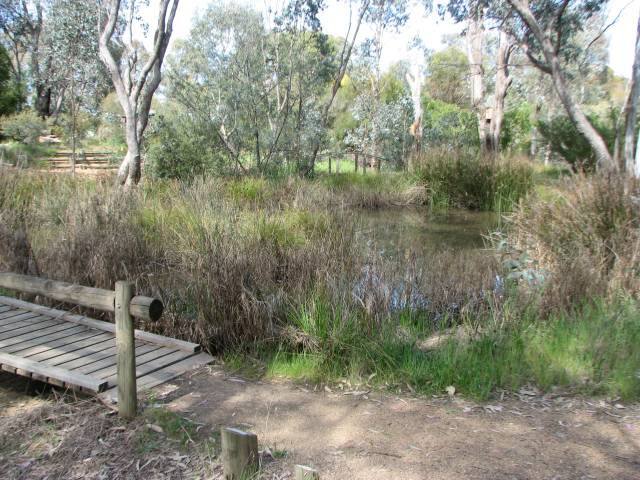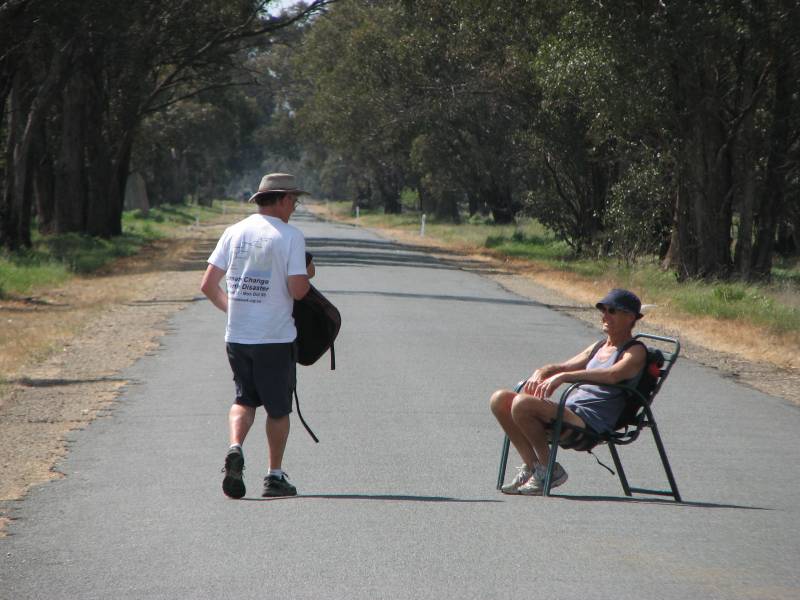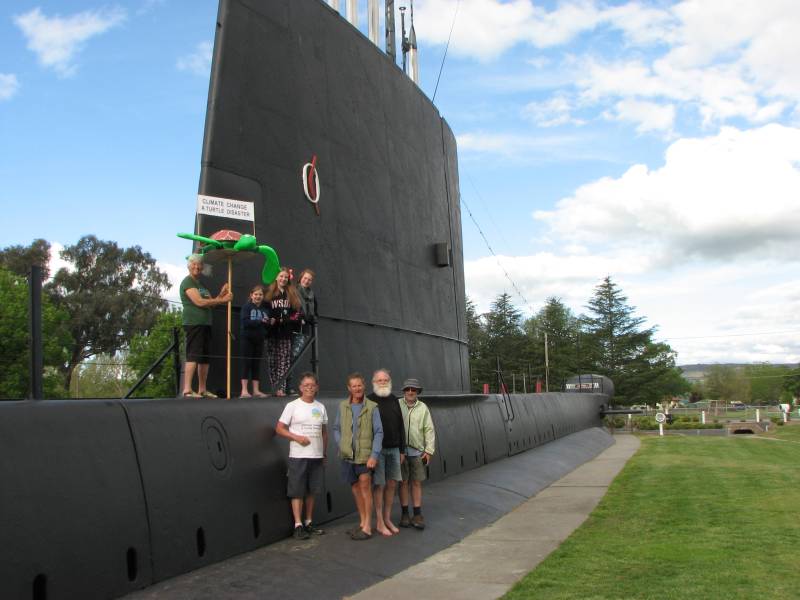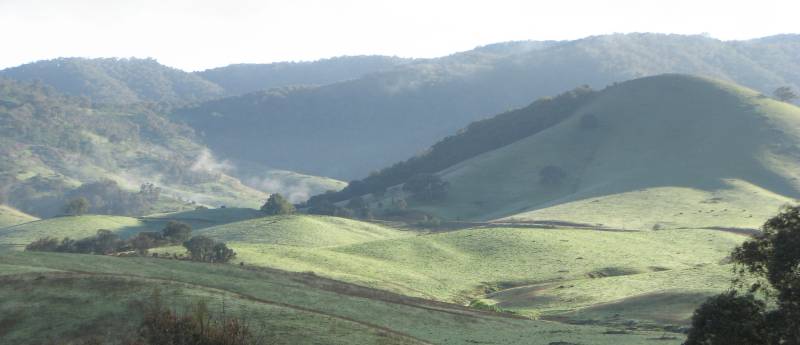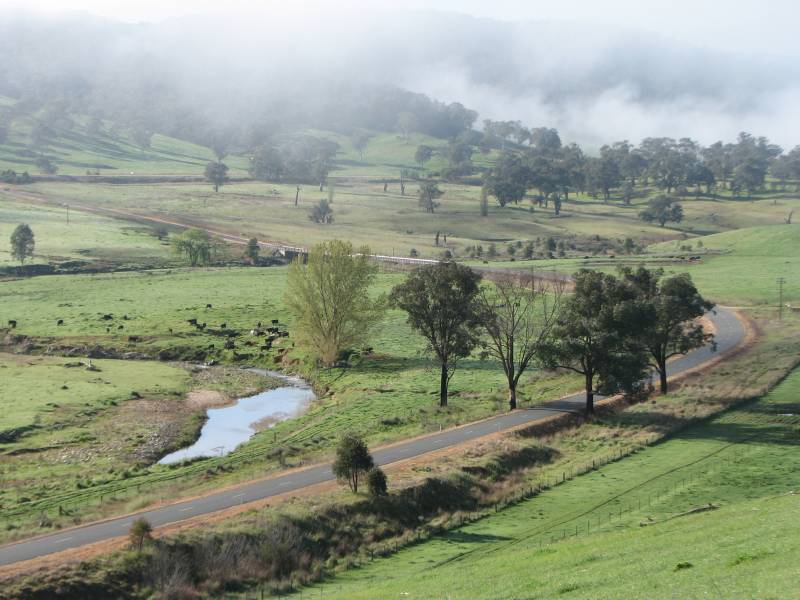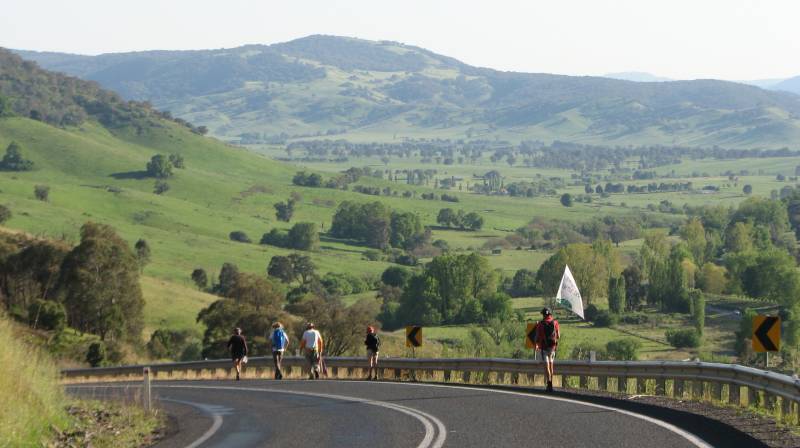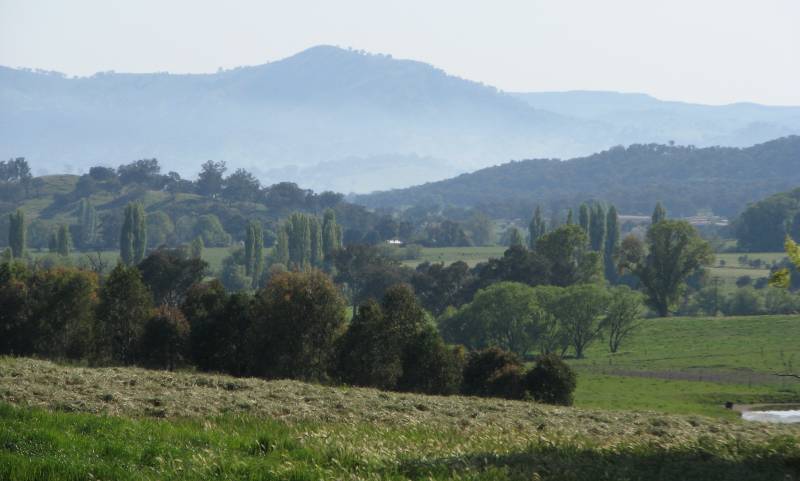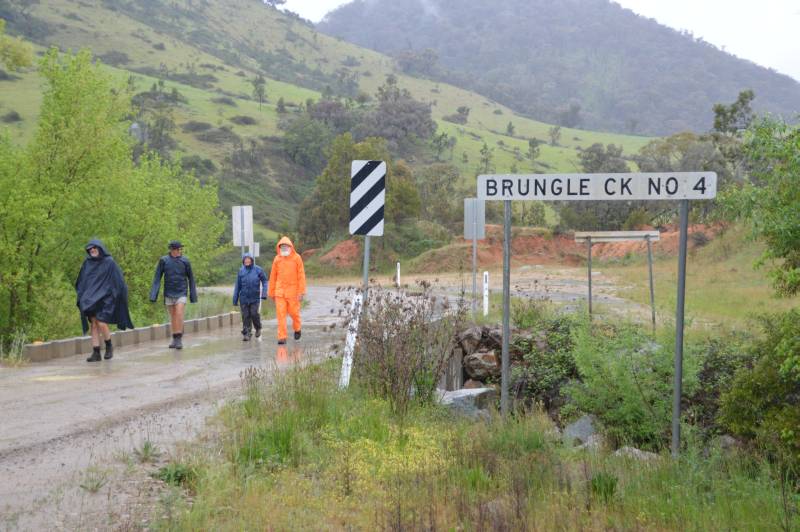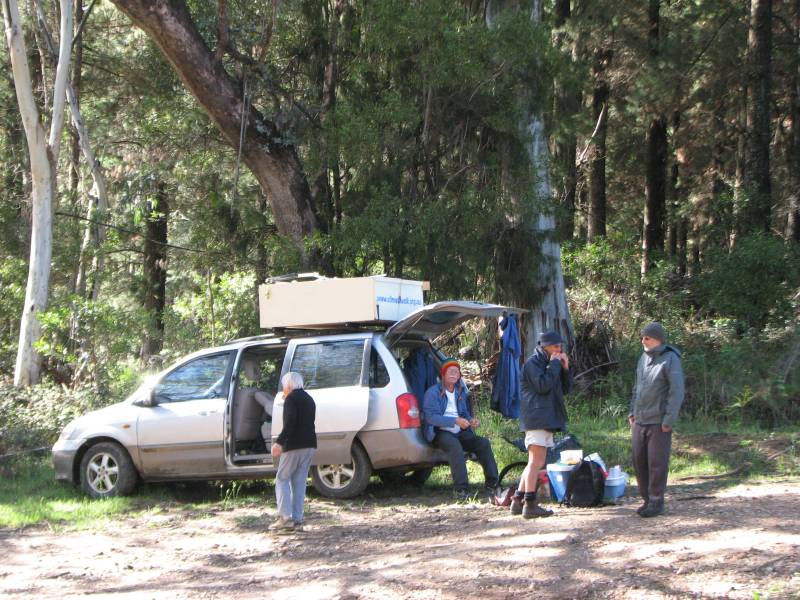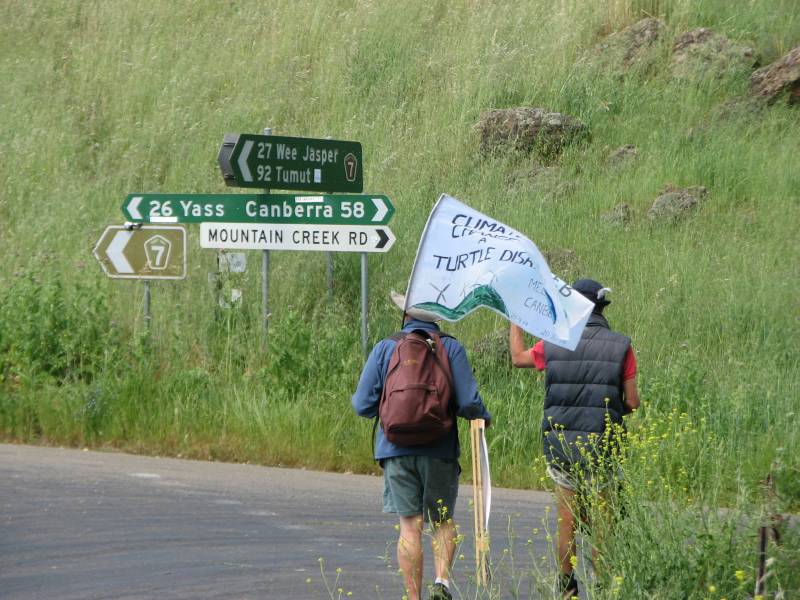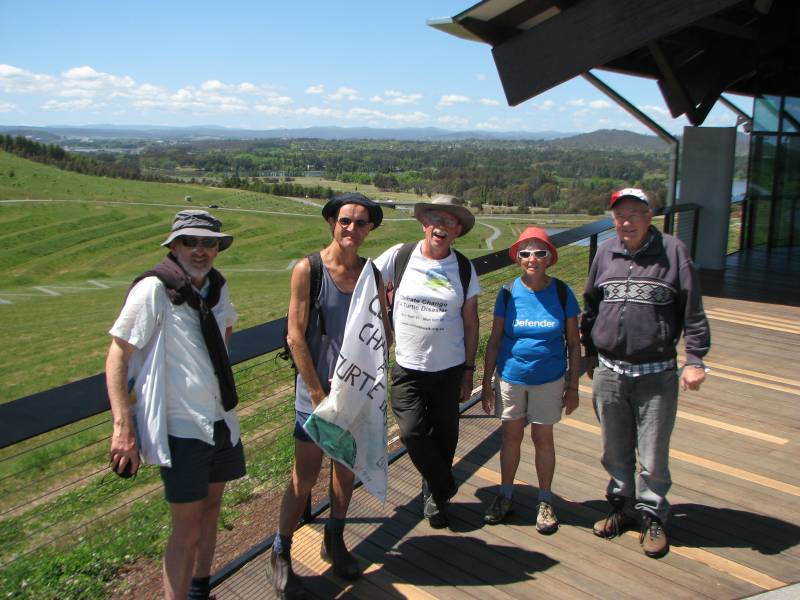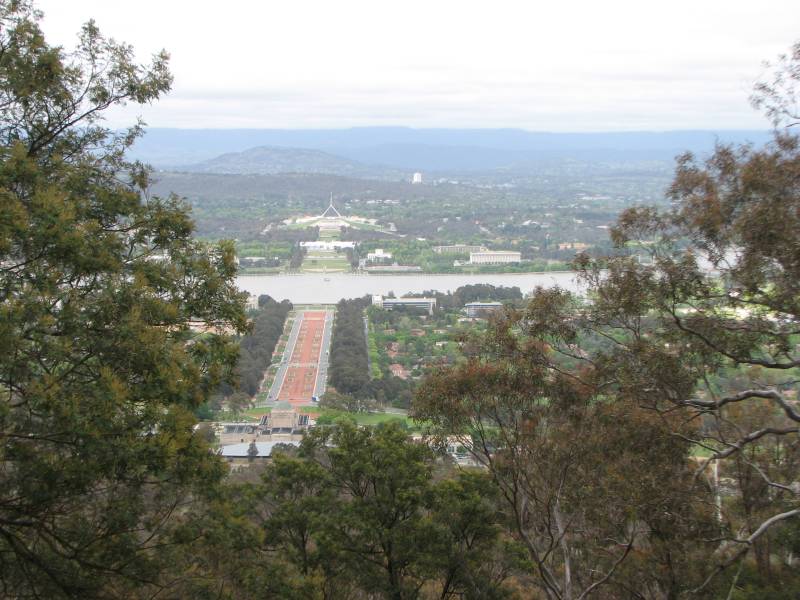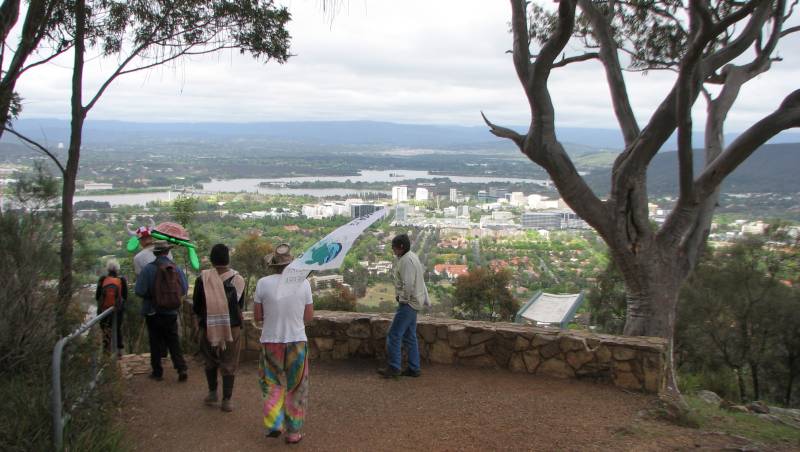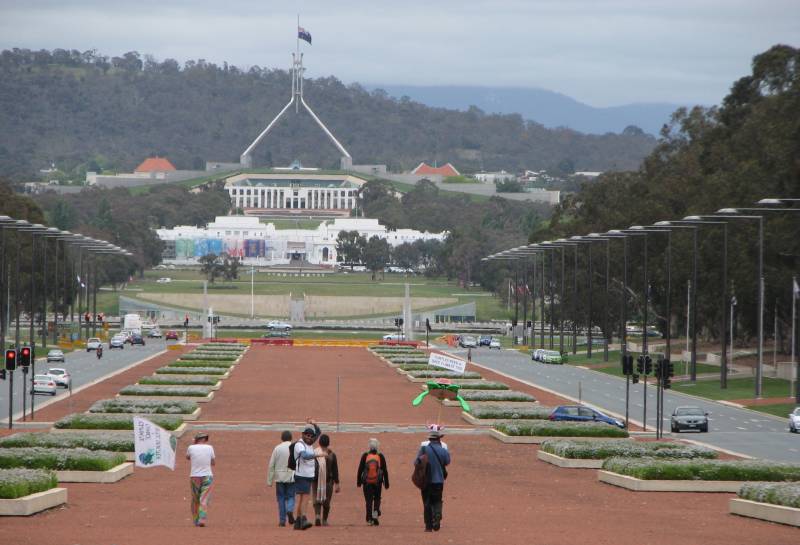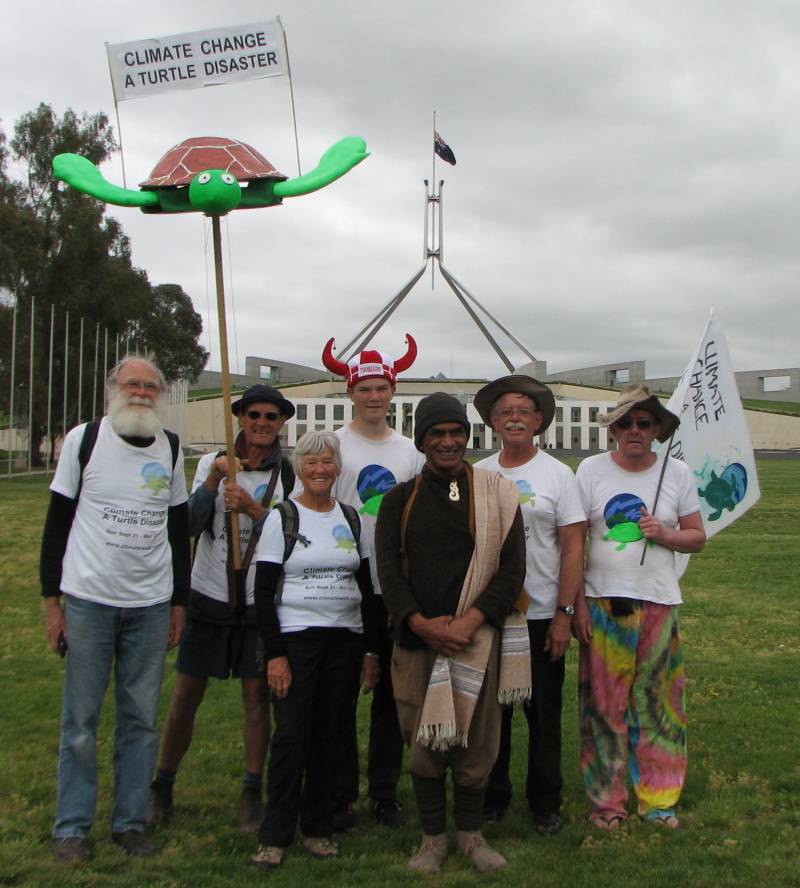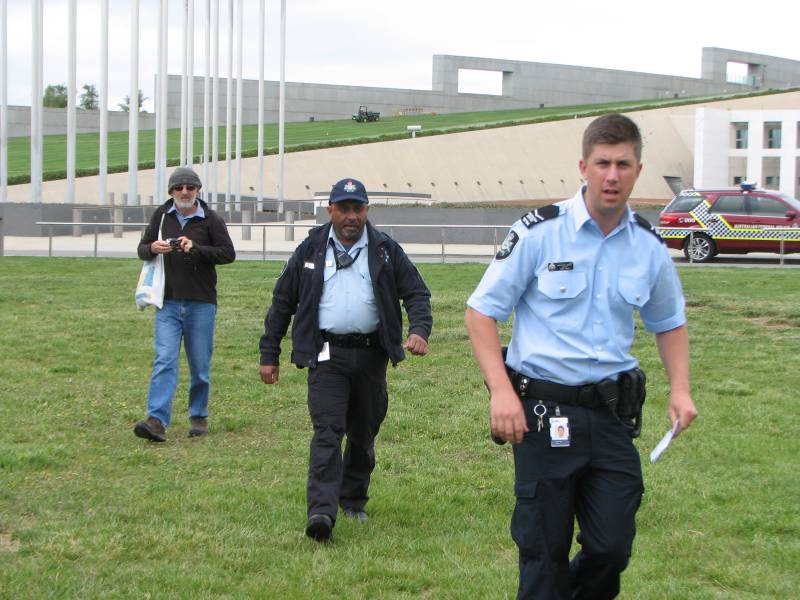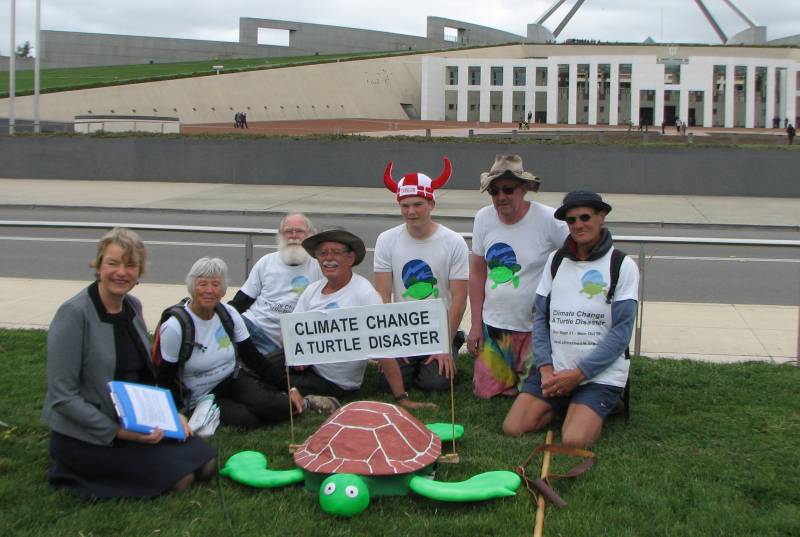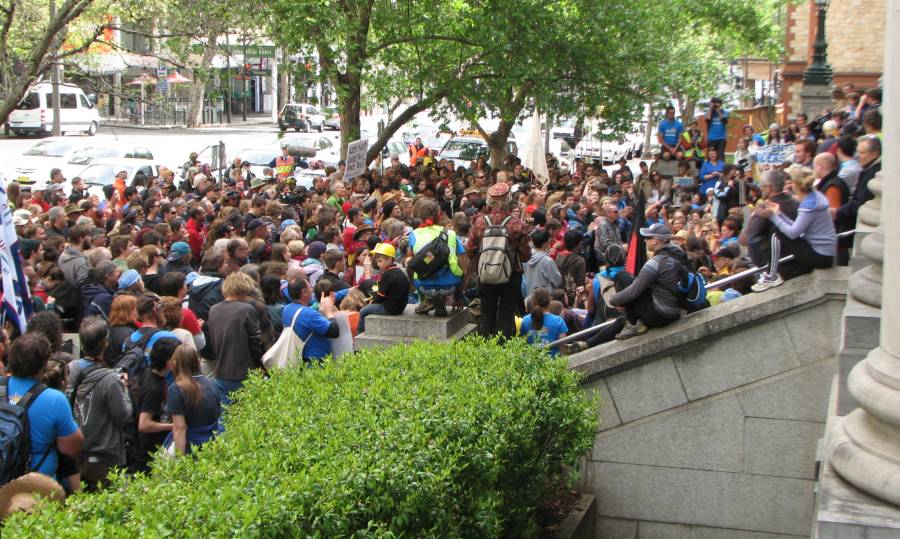Bogged in a muddy gutter.
The rest of the road was very firm, but there was deep mud in the gutter.
We had two back-up vehicles at this point in the walk, Martin's van pulled Alan's out of this bog with little difficulty.
2014/10/01
Approaching Wangaratta.
From left to right: Don, Martin, Alan, Jacquie, Cassandra and June.
Jacquie and Cassandra joined us for most of the day's walk.
2014/10/01
A straight section of road between Wang, as the locals call Wangaratta, and
Rutherglen.
When I first heard the others talking about going to Wang I had no idea what
they were talking about.
2014/10/02
I had a chat to these cattle.
They shared my concern about climate change.
2014/10/02
About to cross the Murray from Victoria into New South Wales
2014/10/04
Approaching Burrumbuttock.
In spite of the odd name it was a very nice little town and the home of a
wonderful Environmental Education Centre which included wetlands and many
labelled native plants.
Early in the walk June insisted that we walk carefully keeping well on the
right side of the road.
Further into the walk we all were pretty relaxed about exactly where we
walked on a quiet road, although we usually walked on the right side.
We could, of course, hear a car approaching from behind well before it got
close to us.
In regard to how we walked this walk was much more relaxed than the
Walk for Solar Power that I had done
two years earlier with a much bigger group. The Walkers for Solar Power were more controlled in exactly where they walked, reasonably so for a bigger group of generally much younger people.
2014/10/05
Right: A small part of the attractive, informative and interesting
Burrumbuttock wetlands and Wirraminna Environmental Education Centre.
2014/10/05
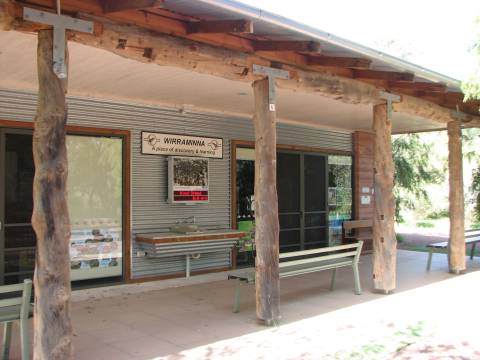
|
| The Education Centre building
|
Right: A home for the native bees at the Environmental Education Centre
at Burrumbuttock.
Each piece of wood has a hole drilled in it and the native bees use these
for their breeding.
2014/10/05
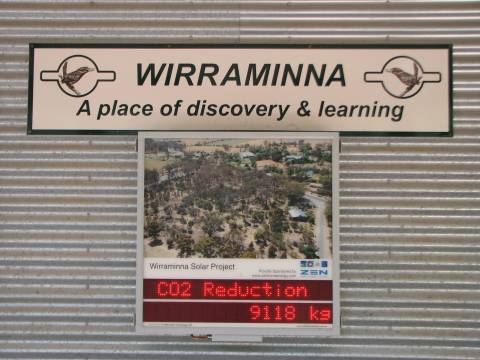
|
| The discovery centre building has solar power and a display of the
amount of CO2 that has been abated in the life of the centre
|
Martin found this old chair by the roadside.
He couldn't resist setting it up in the middle of this quiet road, west of
Holbrook, to wait while Alan and I caught up to him.
2014/10/07
The Oberon class submarine at Holbrook.
On the submarine, holding the turtle, is June.
Beside the sub, from left to right is Alan, Martin, me and Harry (who joined
us on the previous day).
There is a story to the shorts I am wearing.
I neglected to bring any with me, but found the weather to be a bit warmer
than I was expecting.
I bought a pair at a goodwill store, but then left them behind at one of the
many places we stayed.
The shorts I am wearing in this photo are cut down jeans.
2014/10/07
A view from the first stop of the day.
It was a lovely day, some cloud on the higher hills in the early morning,
but a clear sky all day.
I only walked about 11km on this day (and not at all on the previous
day); my feet, particularly the right Achilles tendon, were giving trouble.
From this point my feet slowly improved.
2014/10/09
This blister popped up on the heal of my left foot on about day 16.
You would think if there were no blisters in the first week or so, there would
be none at all, but no.
Now, perhaps 3 days later, it was causing little discomfort.
2014/10/09
Silhouetted gum trees in the early morning near Lankey's Creek
2014/10/09
Morning mist on the river valley at Lankey's Creek.
My feet were giving trouble at this point so I drove the car ahead to wait
for the other walkers.
So I watched how the appearance of the landscape changed as the sunshine came
and went and the morning mists gradually lifted.
2014/10/09
The walkers go down the last big hill on the Tumbarumba road to Tumut.
This area was perhaps the most attractive country of the walk, but there were many beautiful places along the way.
2014/10/12
Some of the beautiful country south of Tumut.
My feet gave me an interesting day on this stretch.
We typically broke the day's walk up into five sections: two 8km sections
followed by three 5km sections.
Usually lunch follows the first 5km section.
On this day my feet were good on the first section, gave me quite a bit of
pain (right Achilles tendon) on the second section, were fair on the third
section, I skipped the forth section, and they were good on the last section.
Odd, don't you think?
2014/10/12
Alan (on left) walking back after driving the car forward had collected
another bag of roadside rubbish.
At the same time (not shown on the photo – he was behind me) Garry
had collected another bag of rubbish.
Martin and I later picked up the bags as we drove back to pick up Martin's
van.
Garry and exchange student Daniel (from Denmark) joined us for two days from Tumbarumba.
Garry McClelland, his wife Dianne and Daniel hosted us one night in Tumbarumba.
Walking on the road was Harry, who joined us at Culcairn, and Martin next to him carrying the flag.
2014/10/12
There was only one wet and cold day on the whole walk.
This was it.
The temperature did not rise above 9 degrees and it rained lightly almost
non-stop the whole day.
The only good thing about the weather was that there was no wind.
We were between Tumut and Wee Jasper, in very sparsely settled country.
With great good fortune we came across a little church that had a sheltered
porch around lunch time.
(I drove over the same route a few years later and placed a
photo of the church on a page written
about that trip.)
Harry, Martin, June and Me.
Alan took the photo.
2014/10/14
Having a short break from walking in the forests of Wee Jasper.
It was a much nicer day that the one before.
The road from Tumbarumba to Canberra was fairly hilly.
The highest altitude we got to was about 1040m between Tumbarumba and Tumut.
Most of the traffic heading toward Canberra from Melbourne seems to go via Holbrook and Gundagai to Yass and then turns down southward to Canberra. The way we went, through Tumbarumba, Batlow, Tumut and Wee Jasper (see the map of the walk) had far less traffic and was more scenic. It is also a good road to drive if you want to enjoy the country rather than just getting to Canberra as quickly as possible.
2014/10/15
This is one of the first sign-posts we saw that mentioned Canberra.
It gave the impression that the people who put up road signs in NSW don't
really want to recognise the existence of the national capital.
2014/10/16
Our first glimps of the final objective, the big flag pole on top of
Parliament House, Canberra.
Seen from about 12km away.
2014/10/18
We have arrived at Canberra Arboretum!
From the left: walkers Harry, Martin, Alan and June.
On the right is Bill Gresham who lives in Canberra, is a veteran of the
Port Augusta to Adelaide Walk for Solar Power, is a
good friend of mine, and who came to meet us (in his electric car if I
remember rightly; it must have been pretty new then).
2014/10/18
On the last day we walked from the top of Mount Ainsley to Parliament House
to deliver the petition asking for serious action on climate change.
Perhaps readers will not be surprised to learn that PM Abbott was not on hand to accept the petition (of six hundred names and signatures) from us.
He probably was busy kowtowing to some coal industry mogul.
This photo is looking from the top of Mount Ainsley
toward the objective, Parliament House.
The flag pole is visible in the distance.
2014/10/21
Starting the walk down the mountain.
On the right, with the sunlight nicely picking it out, is the Canberra
city centre.
2014/10/21
Walking along Anzac Parade.
Old Parliament house in the middle distance, the new one on the rise behind
it.
2014/10/21
The group who took the petition (and the turtle) to Parliament.
Left to right: me Martin, June, Daniel, Winiater (who walked with us on the
two last days), Alan and Garry.
2014/10/21
Alan, our leader, handing the petition to Senator Janet Rice, Australian
Greens Senator for Victoria.
It seems that the Greens are the only political party who are particularly
interested in the future of the planet.
2014/10/21
Old Bill coming to get us?
They looked a bit intimidating, but were very polite and simply needed to
know what we were doing.
2014/10/21
In front of Parliament House, our immediate objective achieved.
From left to right, Senator Janet Rice (Australian Greens) with our petition,
June, me, Alan, Daniel, Garry and Martin.
2014/10/21


